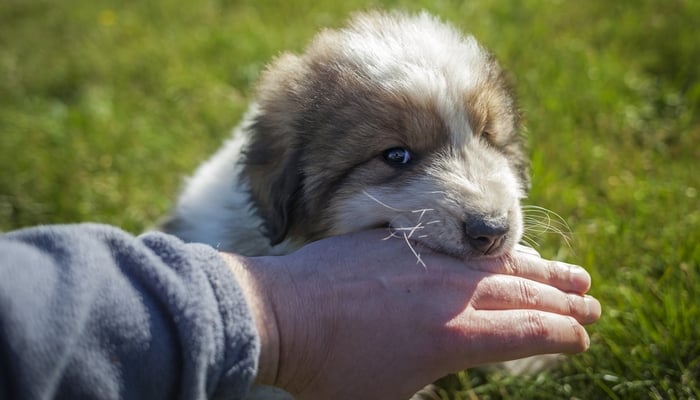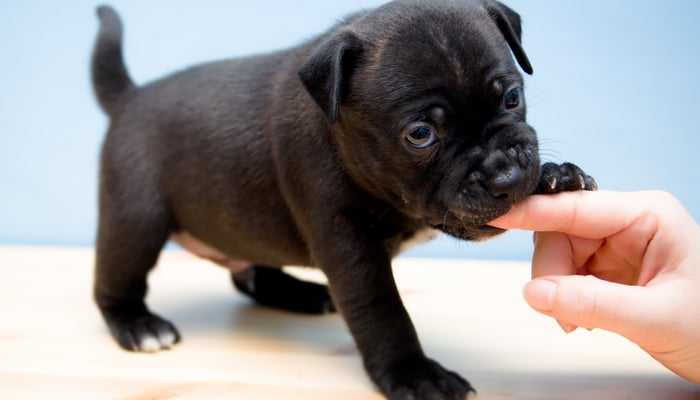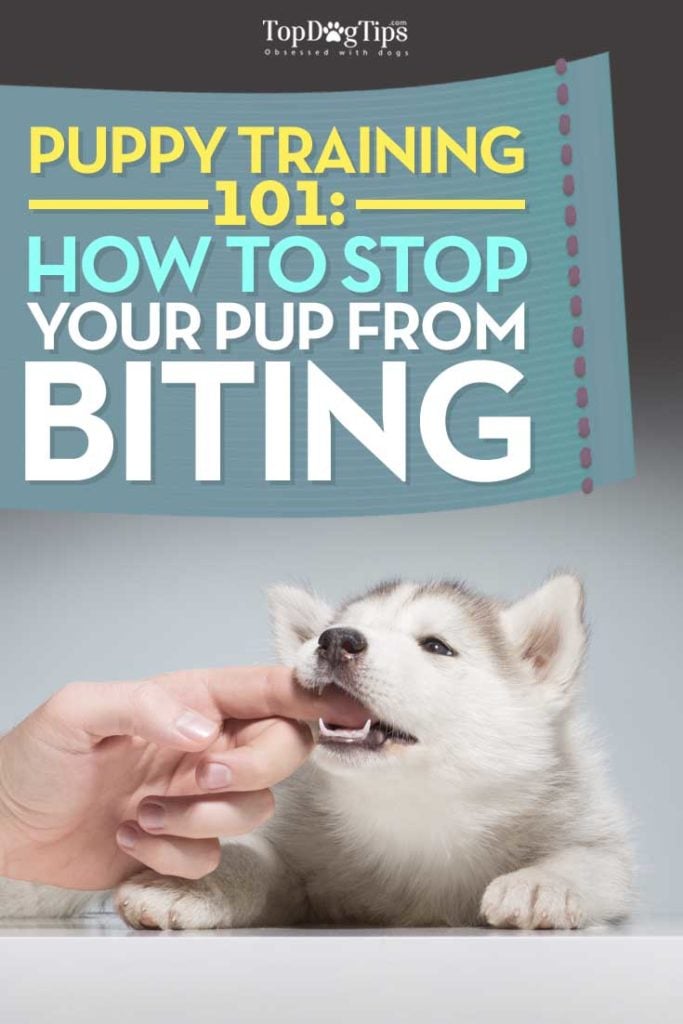Some new pet owners think that puppy biting is just a cute way for young dogs to play with their owner. However, it's a bad habit that needs to be nipped in the bud. Learning how to stop a puppy from biting is essential if you want to raise a well-behaved dog.
Table of Contents
- How to Stop a Puppy from Biting
- 1. Avoid “Biting Games” with Your Puppy
- 2. Consistency with Puppy Biting Inhibition
- 3. Use Verbal Cues to Stop Puppy from Biting
- 4. Don't Make Biting Inhibition Training Into a Game
- 5. Redirect Puppy's Behavior with a Dog Toy
- 6. Puppy Biting While Petting
- 7. Use Deterrent Sprays to Stop Your Puppy from Biting
Why Do Puppies Bite?
Mouthing and biting in puppies are natural behaviors. Young dogs prefer using their mouths instead of their paws to manipulate and explore things in their environment.
Like human babies, puppies go through a teething stage. During this stage, they try to chew on everything as a means to soothe their mouth. It's one of the critical periods of a young dog's stage of life.
While puppy biting and mouthing appears cute, remember that a puppy's teeth are sharp. They can cut through human skin with little pressure. If you've ever played with a puppy, you've probably experienced small piercing holes that their teeth leave in your hand. Even if it's not painful and you don't mind it, this behavior must be stopped.
As your new young dog continues to grow, his teeth will become less sharp, but his jaw will be become more powerful. And if you don't stop puppy biting behavior in its initial stage, it's going to be more difficult to deal with later in a dog's life. That's when biting can cause actual harm and other problems. It's one of the most common reasons why dog owners eventually give up their pets.
It's important to learn how to stop a puppy from biting as soon as possible. It's easier to curb the bad behavior in its very beginning, when the dog is still young and in his initial development stages, than it is to try and put an end to the habit after it has been formed.
RELATED: 25 Most Common Dog Behavior Problems & How to Fix Them
How to Stop a Puppy from Biting
1. Avoid “Biting Games” with Your Puppy
Pet owners like to play the game which I to refer to as “The Claw” with their puppies. The way this game works is like this: you place your hand above your dog's head, wiggle your fingers and move your hand around so the puppy chases it. We all know it.
What this does is teaches the puppy that biting your hand can be a fun game.
I've also seen pet owners wiggle their feet when their new dog is lying on the ground. While these “games” are fun and adorable, they send the wrong message to your dog.
Dogs are clever animals that learn things from us, just as our kids do. We already know not to teach our children bad habits from the very beginning, yet we still ignore this rule when it comes to puppies. In other words, you will reap what you sow, so be careful.
2. Consistency with Puppy Biting Inhibition
Did you know that puppies typically learn biting inhibition from other puppies? However, when you adopt a dog that's alone, you take this responsibility upon yourself.
One of the most important factors in dog training is consistency. You cannot allow your puppy to bite or chew on your body at any time, ever.
Staying consistent will show your dog that biting is unacceptable at any time. This also means that you need to talk with other family members, guests and especially kids in your household to make sure they are on the same page.
When your puppy bites, give him a clear signal that this is an unwanted behavior. Never miss your cue on this, and stay consistent with these signals.
Unsurprisingly, biting inhibition is one of the most common warnings pet owners receive from animal shelters, veterinarians, dog trainers and canine experts. It's a problem that a large majority of pet owners have to deal with but often ignore until it's too late.
3. Use Verbal Cues to Stop Puppy from Biting
As I explain in my video above, puppies will make a high pitched yelp to notify another puppy when they are biting too hard. Mimicking this sound is a natural way to show a puppy that you don't like what he is doing and that his behavior is unacceptable.
If you don't like the idea of making a high pitched yelping sound, you can use your own verbal cue. I like using a simple “ow” sound.
As soon as your puppy begins to bite you, make the sound of your choosing and then let your hand go limp. Always use the same sound as the verbal cue command to stop puppy mouthing, and stay consistent with it.
Use the verbal cue training practice no more than 3 times within a 15 minute period.
If you need to do it more than 3 times in 15 minutes, it's time for a time out. Place your puppy in his dog crate, or a playpen, or other secluded area. Ignore him for at least 15 minutes before showing him any more attention. This will help to reinforce the training and show him that biting is not an acceptable behavior.
4. Don't Make Biting Inhibition Training Into a Game
A word of caution: as tempting as it is, avoid trying to make this into a game.
Basically, if you move your hand too quickly or try to fight back by pushing your dog away, his natural chase instinct will kick in and this will quickly become a game to him. Instead, your puppy must associate this behavior with something that shouldn't be fun.
Furthermore, some dog owners also have a problem that's closely related to learning how to stop a puppy from biting, and that is with puppies who chew incessantly. Both of these behaviors are related. So if that's the case with your dog, read/watch this guide.
5. Redirect Puppy's Behavior with a Dog Toy
Another method to try when learning how to stop a puppy from biting is redirection. There's a lot of puppy toys suitable for this redirection training, and most of them are also great for your puppy's teething itch.
For example, when you're holding your new dog, keep a motivating puppy toy within reach. I like to use a squeaky dog toy because it attracts attention. Remember to choose the right toy for your dog. Some of them may be ineffective or downright dangerous.
Here's what you do with the dog toy: when your puppy begins to bite you, redirect his attention directly to the toy. When the dog takes the toy, begin to play a non-contact game (like tug or fetch). This will teach your puppy that biting is unacceptable, but there are other fun things that you can do together that don't require teeth-to-skin contact.
This is especially important when dealing with dogs that are ankle biters.
It is common for puppies to chase your feet while you walk and try to grab a hold of your feet, legs, clothing or shoes. When your feet move, your dog sees them as a fun object to chase. Again, this may look cute but it's a behavioral problem that needs to be fixed.
If you have an ankle biter, keep a toy on hand when you're walking around. Redirect a dog's attention to the toy, and then play with him to burn some of that excessive energy.
6. Puppy Biting While Petting
Your new puppy may enjoy chewing on your hands while you pet him. As I mention in my video above, this is a common problem that is easily fixed with positive reinforcement.
Here's what you do:
When the puppy first starts biting you as you pet him, redirect him by using dog treats. Pet your pup with one hand and keep a few treats in the other. When he allows you to pet him for a short period without biting, reward him with a treat.
If puppy starts to bite as you pet him, show him the treats but don't give him any just yet. After he's seen the treats, start petting him again. If he doesn't bite this time, reward him with a dog treat to reinforce this positive behavior.
Using puppy treats is the most effective way to train young dogs as it reinforces behavior in them that is acceptable. Studies show (PDF), and dog experts and vets agree that positive reinforcement is the first dog training aspect that all owners should learn about.
Note: There is a chance that your dog is only biting because he's bored. In this case, dog treats may not work. If he doesn't seem to be learning with the treat training, redirect him with a puppy toy instead, as I've mentioned above.
7. Use Deterrent Sprays to Stop Your Puppy from Biting
If you’ve followed this guide on how to stop a puppy from biting all the way through, and nothing seems to be working with your dog, try a deterrent spray. It should be your last resort, since command dog training usually works for most behavioral problems in dogs, and not just biting.
What's a dog deterrent spray? It's a specifically formulated dog-safe spray that will make your skin taste bad to your puppy. As long as you use a good quality, non-toxic and safe repellent, there will be no issues with the puppy coming in contact with it.
I would recommend using an all-natural formula, because any products with chemicals or artificial ingredients will not be healthy for you or your dog. Some of my favorite dog deterrent sprays for puppy biting behavior are these three below:
| Preview | Product | Rating | |
|---|---|---|---|

|
Grannick's Bitter Apple Taste Deterrent Spray... | 19,136 Reviews | Check Price |

|
Rocco & Roxie No Chew Spray for Dogs, More Yuck... | 9,569 Reviews | Check Price |

|
Anti Chew Dog Training Spray: No Chew Bitter Spray... | 1,940 Reviews | Check Price |
Dog deterrent sprays like those above will leave a bad taste in your pet's mouth, thereby teaching a puppy that biting is not pleasant. Deterrent sprays for dogs are formulated to discourage puppies from wanting to bite or chew the object again, and they are very effective. You can use them for other things as well, not just your skin.
However, you should only use a puppy deterrent as the last resort.
Why? Because you want to teach and train the dog that it's not okay to bite human skin at all, not just when it doesn't taste good. Using these products in conjunction with proper dog training methods would be the most effective and proper way to ensure that your dog understands that it is never acceptable to bite or chew on humans.
Training puppies can be a fun endeavor when you know how to do everything correctly. As long as you stay consistent and avoid mistakes that will “come bite you” in the future, you should see results of effective puppy training almost right away.
READ NEXT: How to Train a Dog Basic Commands
Disclosure: We may earn affiliate commissions at no cost to you from the links on this page. This did not affect our assessment of products. Read more here and find full disclosure here.

















